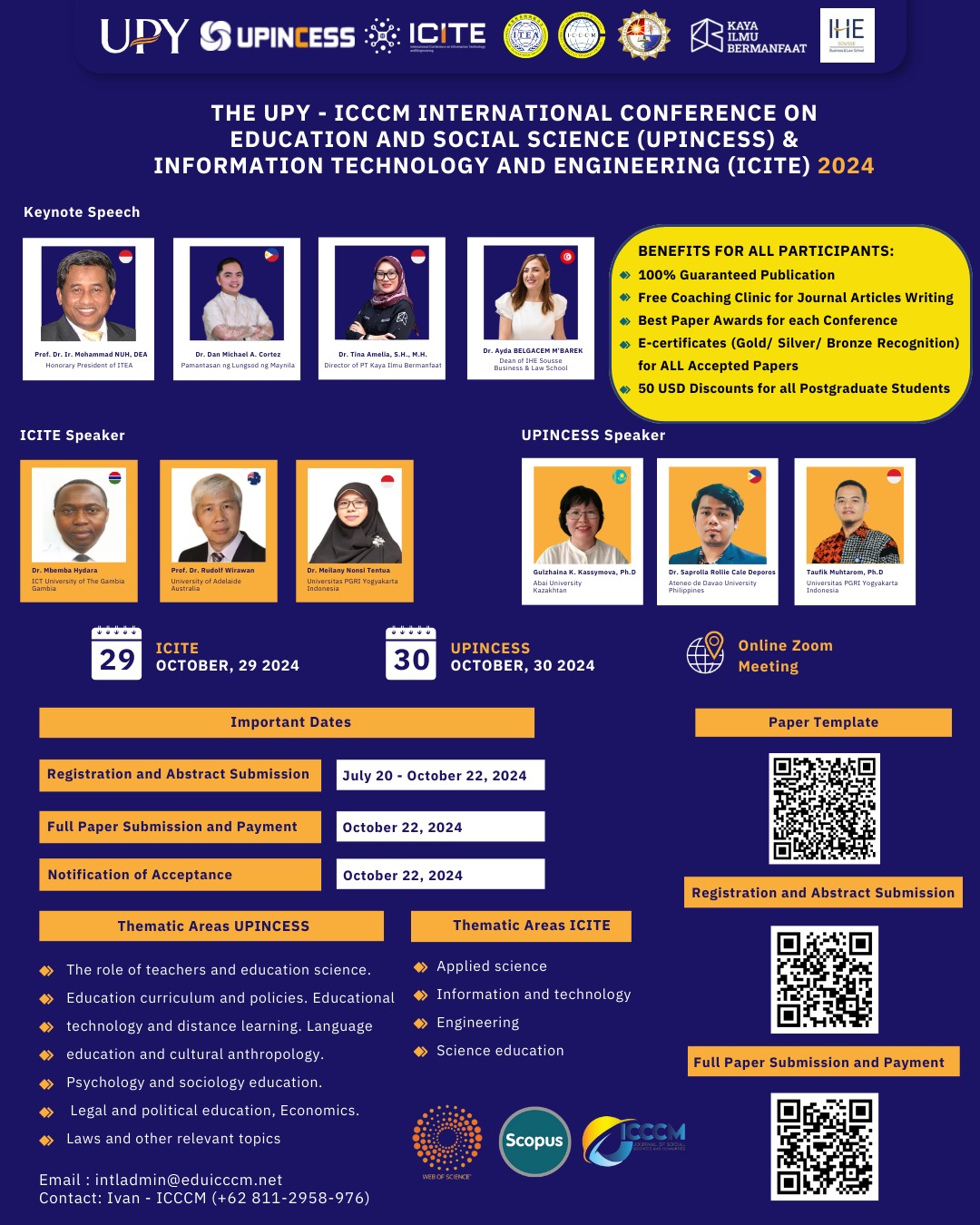Effectiveness of Indonesian Language Module Development Based on Canva Apps
DOI:
https://doi.org/10.53797/icccmjssh.v3i5.8.2024Keywords:
Module, Indonesian language, Canva apps, critical thinkingAbstract
The purpose of the research is to analyze the effectiveness of the Indonesian language module based on Canva Apps to improve the critical thinking skills of fourth grade elementary school students in Pati Regency. The research design used in this research is using an experimental research method of the Quasi-Experimental Design type in the form of Nonequivalent Control Group Design. The research was conducted in elementary schools, precisely in the Ki Hajar Dewantara cluster, Trangkil Pati District. Data collection techniques use observation and questions. Data analysis uses instrument tests (validity test, reliability test, differential power test and difficulty level test), prerequisite tests (normality test and homogeneity test), and hypothesis tests (independent sample t-test, paired samples test and n-gain test). The results of the research show the effectiveness of the Indonesian language module based on Canva Apps based on the results of the t test > t table (6,582> 2.0244) and the general test results obtained a value of t count > t table or 20,568 > 2.0010. and sig count < 0.05. The conclusion is that the Indonesian language module based on Canva Apps is good and effective for improving the critical thinking skills of fourth grade elementary school students in Pati Regency.
Downloads
References
Akbar, R. A. (2023). Critical thinking as a twenty first century skill. Journal of Educational Research and Social Sciences Review (JERSSR), 3(1), 8-15.
Aneshie-Otakpa, V. O., Andor, S. E., & Sani, D. A. (2021). Effect of flipped classroom instructions on secondary school students’ critical thinking and achievement in matrices and determinants. African Journal of Science, Technology & Mathematics Education (AJSTME), 6(1), 157-165.
Carroll, J. B. (2012). Intellectual abilities and aptitudes. In Foundations for a psychology of education (pp. 137-198). Routledge.
Dumciuviene, D. (2015). The impact of education policy to country economic development. Procedia-Social and behavioral sciences, 191, 2427-2436. https://doi.org/10.1016/j.sbspro.2015.04.302
Grajcevci, A., & Shala, A. (2016). Formal and non-formal education in the new era. Action Researcher in Education, 7(7), 119-130.
Higgins, S. (2014). Critical thinking for 21st-century education: A cyber-tooth curriculum?. Prospects, 44(4), 559-574. https://doi.org/10.1007/s11125-014-9323-0
Jutep, R. J. (2024). The Influence of The Use of Canva Application-Based Learning Media On The Indonesian Language Learning Outcomes of Grade X Students Of Smks Muhammadiyah Sidenreng Rappang. RADJA: Journal of Education, 1(1), 1-8.
Lou, S. J., Chen, N. C., Tsai, H. Y., Tseng, K. H., & Shih, R. C. (2012). Using blended creative teaching: Improving a teacher education course on designing materials for young children. Australasian Journal of Educational Technology, 28(5), 776-792 https://doi.org/10.14742/ajet.816
Makbul, M., Ferianto, F., Husain, N., & Farida, N. A. (2024). The Influence Of Investigation Group Type Cooperative Learning On The Critical Thinking Ability Of Students Of The Islamic Religious Education Program University Of Singaperbangsa Karawang. Conciencia, 24(1), 01-14. https://doi.org/10.19109/0x3y7t45
Moustaghfir, K., & Schiuma, G. (2013). Knowledge, learning, and innovation: research and perspectives. Journal of knowledge management, 17(4), 495-510. https://doi.org/10.1108/JKM-04-2013-0141
Mulawarman, W. G. (2021). Overcoming Obstacles in Implementing 2013 Curriculum Policy. Cypriot Journal of Educational Sciences, 16(3), 967-980. https://doi.org/10.18844/cjes.v16i3.5770
Ongardwanich, N., Kanjanawasee, S., & Tuipae, C. (2015). Development of 21st century skill scales as perceived by students. Procedia-Social and Behavioral Sciences, 191, 737-741. https://doi.org/10.1016/j.sbspro.2015.04.716
Prihandoko, Y., Prastitasari, H., Kurahmah, T., Fendrik, M., & Istianah, T. N. (2023). Implementation of the PREMIER model based on river area to improve fourth-grade students’ mathematical problem-solving ability. Journal Of Teaching and Learning In Elementary Education, 6(1), 27-38. http://dx.doi.org/10.33578/jtlee.v6i1.7955
Sanjaya, W., Erita, Y., Putri, R. S., & Indriyani, N. (2022). Teachers' readiness and ability in designing teaching modules in the independent curriculum. Journal of Digital Learning and Distance Education, 1(7), 288-296. https://doi.org/10.56778/jdlde.v1i7.46
Saputra, A. G., Rahmawati, T., Andrew, B., & Amri, Y. (2022). Using Canva Application for Elementary School Learning Media. Scientechno: Journal of Science and Technology, 1(1), 46-57. https://doi.org/10.55849/scientechno.v1i1.4
Sari, H. R., & Yatri, I. (2023). Video Animasi Melalui Aplikasi Canva Untuk Meningkatkan Hasil Belajar Bahasa Indonesia Siswa Sekolah Dasar. Edukasiana: Jurnal Inovasi Pendidikan, 2(3), 159-166. https://doi.org/10.56916/ejip.v2i3.381
Taft, M. M. (2015). Higher-Order Critical Thinking in Teacher Preparation: Putting 21st Century Skills Into Action. In Transformative Researchers and Educators for Democracy (pp. 57-73). Brill.
Wati, R., & Daulay, E. (2023). The Developing of Indonesian Teaching Materials For Foreign Speakers by Using Canva Media. English Teaching and Linguistics Journal (ETLiJ), 4(1), 59-66. https://doi.org/10.30596/etlij.v4i1.13416
Wulandari, T., & Mudinillah, A. (2022). Effectiveness of Using the CANVA Application as a MI/SD Science Learning Media [Efektivitas Penggunaan Aplikasi CANVA sebagai Media Pembelajaran IPA MI/SD]. J. Ris. Madrasah Ibtidaiyah, 2(1), 102-118.
Downloads
Published
How to Cite
Issue
Section
License
Copyright (c) 2024 Hidayati Tri Farus, Rismiyanto, Mohammad Kanzunnudin

This work is licensed under a Creative Commons Attribution-NonCommercial-ShareAlike 4.0 International License.




